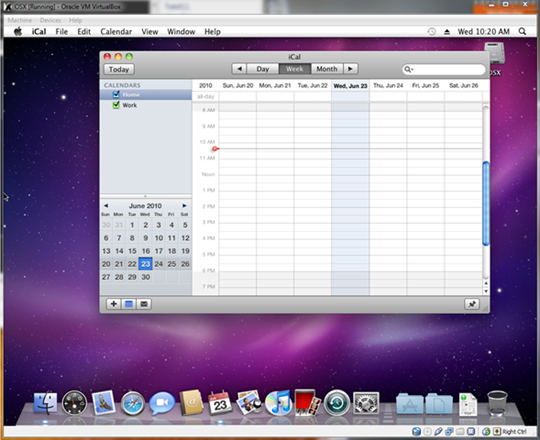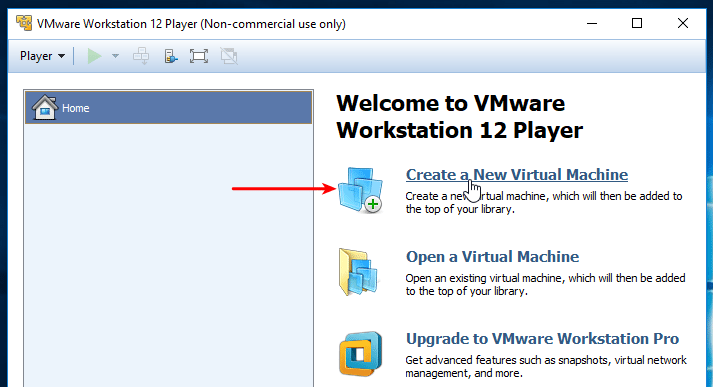- Vmware Or Virtualbox For Mac
- Vmware Or Virtualbox For Mac Os X On Windows Bootable
- Mac Os Virtualbox
- Vmware For Mac
Presently, VirtualBox runs on Windows, Linux, Macintosh, and Solaris hosts and supports a large number of guest operating systems including but not limited to Windows (NT 4.0, 2000, XP, Server 2003, Vista, Windows 7, Windows 8, Windows 10), DOS/Windows 3.x, Linux (2.4, 2.6, 3.x and 4.x), Solaris and OpenSolaris, OS/2, and OpenBSD. If you're already using a Mac Virtual Machine, you'll be aware of what VirtualBox and VMWare, Virtual Machines that allow you to transfer files from mac to pc and this using ethernet (NAT). The tutorial that we're going to run you through today will show you how to move files between your Mac or Virtual Machine and your new Windows PC.
macOS Mojave 10.14 is one of the latest and off the mark operating systems launched by Apple. macOS Mojave updates lead to improvisation in the strength, execution, or agreement with your Mac and are prescribed for all Mojave clients.

Apple launched its very new macOS Mojave which includes influential selling focuses such as Continuity Camera, Dark Mode, Stacks to limit your work area with the documents.
License
Official Installer

File Size
6GB
Language
Multilingual
Jul 11, 2014 Virtualbox: This virtualization suite is free, and though it doesn’t offer official support for Mac OS X, it works well enough.; Mountain Lion bootable DVD: Unfortunately, the standard method for installing OS X Mountain Lion on PCs (which uses a paid copy of the Mountain Lion installer) doesn’t work with Virtualbox.
Developer
Apple Inc.
Some sumptuous peculiarities associated with the latest macOS Mojave 10.14 are as mention below
- The newly included feature of macOS Mojave is the Dark Mode arena, which you can opt for at the time of installing this operating system. Hence, on the off chance that you wish to apply the light mode, at that point you can.
- Dynamic Desktop: It is with a dim mode that the work area inclinations are fixed with the light mode, and your backdrop on the work area is well situated.
- Desktop Stacks: Here, you can store various types of folders displaying the same file names on the macOS Mojave work area.
- Screen Mark-ups:Earlier you were expected to isolate the application on the screenshot, however now you can outline, draw, include content, shapes, and crop pictures in whichever way you wish to do it.
- Screen Utility: macOS Mojave likewise includes a screen capture taskbar, where you can without much of a stretch take a screen capture!
- Coherence Camera: Now straightforwardly you can transfer or upload photographs from iPhone iPad, or from some other Apple gadget.
- iOS Applications on Mac: After downloading the updates of macOS Mojave, you can utilize the iOS Apps on your desktop.
- The App Store: It facilitates you to Work, Create, Play, =and develop with the App Store, in short, all that you are doing on iOS.
- Finder tool: It permits you to convert all your photos into a short slideshow, or even aids you in altering a short video.
Various other macOS Mojave Enhancements are added to the operating system.
Vmware Or Virtualbox For Mac
Also Read:-Download macOS Catalina Image file for Virtualbox and VMWare
- AirPods:Includes support for new AirPods (second era).
- Improves the nature of sound accounts in Messages.
- Gives improved help to outer GPUs in Activity Monitor.
- Improves the dependability of USB sound gadgets when utilized with MacBook Air, MacBook Pro, and Mac scaled-down models presented in 2018.
- Amends the default screen splendor for the MacBook Air launched in 2018.
However, on the off chance that you are a Windows user, at that point testing macOS Mojave gets extremely complicated, That’s the reason a portion of the Mac Users who are well versed with programming and are acquainted with the steps on How to Create a VMDK (Virtual Machine Image) File, have made the VMDK File.
The Best part pertaining to the macOS Mojave VMDK (Virtual machine Image) File is that it tends to run on any working framework like Windows, Macintosh, Linux, etc. At the end of the day, as long as there is the very presence of Virtual Machines, for example, the VMware and VirtualBox, any operating system can be downloaded, installed, tried and tested by any user or any OS.
Why Virtual Machines
- With regards to entering or testing applications, Software or Operating Systems, virtual machines are the ideal choice to go with. They permit you to run diverse, one of a kind operating systems, run programs on them or have a go at installing whichever applications you like.
- They run on a sandboxed environment that is altogether out of your real working framework. Despite which operating system you’re as of now employing, you can introduce pretty much every operating system and do far more terrible things. This can be running a noxious or even worse which you’re probably not going to do inside your current Operating System. When there’s something not right, you can without any hassle erase the virtual machine whether that is on VMware or VirtualBox.
The following links are available to download macOS Mojave on Virtual Machines:
VMware:macOS Mojave VMware Image Download (One Full – Google Drive)
This is the specially created record file where you can introduce macOS Mojave on the VMware machine. It is a solitary document. On the off chance that you have a rapid web connection, at that point, you need to download the picture. Further, you will peruse the record in your VMware programming. And afterward, you can without much of a stretch introduce the macOS Mojave with default wizard. Thus, It will at that point run macOS Mojave on VMware utilizing Windows 10.
VirtualBox:macOS Mojave VirtualBox Image Download (One Full – Google Drive)
This one is a huge document with one picture download interface. Along these lines, you should have high web speed to download the record. Be that as it may, After the download you need to peruse it to a virtual box and follow the means from the wizard for fruitful establishment.

Vmware Or Virtualbox For Mac Os X On Windows Bootable
Download macOS Mojave 10.14 Virtual Box and VMWare - ISORIVER
macOS Mojave 10.14 is one of the latest and off the mark operating systems launched by Apple. macOS Mojave updates lead to improvisation in the strength,
Price Currency: USD
Operating System: Mac OS Mojave 10.14
Application Category: Virtual Machine Image
Möchten Sie diesen Beitrag in Deutsch zu lesen? Lesen Sie die Deutsch-Version hier.
Thanks to a handy technology called virtualization, running multiple operating systems and applications on a single host machine is now the norm in IT environments of all sizes.
VMware has been the undisputed king of this space for quite some time, but numerous competitors have emerged to challenge its comfy position upon that throne. One of those competitors is IT software giant Oracle, who jumped into the virtual computing game in 2007 with the aptly named VirtualBox.
If you ask, “which is better”, “which should I go with”, or a similar question to knowledgeable IT professionals, most will say that it’s VMware hands down. Ask them to elaborate and they’ll likely tell you that VMware is the ultimate solution for server virtualization, while VirtualBox is best suited for virtualizing desktop environments.

These statements may have some truth to them, but the battle gets far more competitive when comparing Oracle’s VirtualBox to something more similar like VMware Player.
Cost and Licenses
VirtualBox and VMware Player are easily two of the most cost-effective options on the market of x86 processor virtualization software.
Mac Os Virtualbox
Oracle makes its solution available under version two of the General Public License (GPL), an open-source license that allows it to be freely distributed and modified at the source code level to accommodate individual needs in functionality. VMware Player, on the other hand, is only freely available for non-commercial usage.
While both applications are free, both can be upgraded to premium packages as well. For instance, VMware Player gets a functional boost when purchasing a commercial license of VMware Fusion Professional, which runs on Mac OS X as well as Microsoft Windows, Linux and other Unix-like systems. VirtualBox can also be upgraded by purchasing commercial licenses directly from Oracle, which gets you enterprise-level features and support for mission-critical usage.
Vmware For Mac
When factoring in the dual-licensing component, I think it’s safe to say we have a stalemate here.
What to Like
VMware touts its Player software as the most efficient way to run Windows XP in newer operating systems such as Windows 7, 8 and 10. With a solid slab of up-to-date hardware, you can enjoy your legacy apps like XP never went out of style.
Additionally, VMware Player provides an ideal environment for effectively testing new apps right on your desktop, essentially eliminating the need to purchase or lease a server for the same purpose. It also supports restricted virtual machines, which is useful when you want to prevent unauthorized IT personnel from tampering with configuration settings.

VirtualBox’s greatest asset may be its portability. One of its more useful traits is the ability to create a fleet of virtual machines in one host environment and run them in another. For example, an administrator who appreciates the user-friendliness of Microsoft products can set up their VMs in Windows, and then run them in Linux where they are likely to enjoy better performance. Its portability is further enhanced by cross-platform capabilities that allow it to function seamlessly on Windows, Mac OS X, Solaris, and various Linux distributions.
Platform Reliability
If there is one area that sets these two products apart, it may very well be reliability. While Virtualbox is widely considered a rock-solid offering, there are a couple of shortcomings that might limit its value in production environments. For example, my installation occasionally ran slow during testing and basic features such as drag-and-drop seemed to suffer from the pesky bugs that plague a lot of free software these days.
VMWare Player, on the other hand, is renowned for the same stability and dependability associated with the vendor’s commercial products. In fact, this software scores high performance marks across both Windows and Linux platforms. However, it does lack some critical features that can help IT admins sleep easier at night, including snapshots. Snapshots come in handy by allowing you to save a specific state of your VM and restore that state when needed. It’s a real time saver. Virtualbox makes creating and managing snapshots a breeze, and for some users, this luxury alone makes it a winner.
Even with the enterprise functionality and extra support, Oracle’s open-source product is going to have a difficult time competing with VMware all-stars like ESXi, vSphere, and Workstation Pro. In the case of VirtualBox against the more proportionate VMware Player, the playing field is about as level as it’s going to get between these two brands.
In the end, I think most IT experts will agree that both are excellent options for those who either have modest needs or are just getting started with virtualization.
What about the heavy hitters? Check out our take on VMware vs. Hyper V.